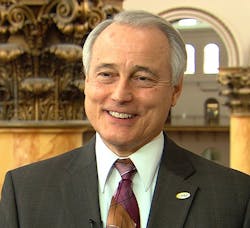DOE's Brodrick Offers Observations on Lightfair
The light cast by last month’s Lightfair trade show and conference in San Diego continues to reflect through the industry as attendees and journalists provide their take on what was meaningful about this year’s event. Jim Brodrick, solid-state lighting technology manager for the U.S. Department of Energy’s (DOE) Building Technologies Office, who tends to be the face of the DOE’s efforts to promote and support the evolution of LED and other solid-state lighting technologies, offered his thoughts in one of his SSL Postings newsletters.
Brodrick said DOE’s educational presentations were the big draw at DOE’s booth, with standing-room-only crowds eager to learn all the nuances of solid-state lighting technology. He did get out to explore the show floor, and shared his observations.
One thing that struck us was the growing responsiveness of manufacturers to input from customers on what matters most to them. Sometimes that’s cost — as reflected in the fact that there was more emphasis this year on designs to drive costs down, despite some resulting tradeoff dips in performance (e.g., we saw more use of chip-on-board packages in luminaires, which typically causes a reduction in efficacy as well as a need for more aggressive glare mitigation because of the high-intensity source). Sometimes customers want products that perform in specific ways to meet the demands of certain applications — such as the one with LED chromaticity intentionally five steps below the blackbody locus, and the many outdoor luminaires offering 2700K and 3000K options. And sometimes customers simply want increased visual comfort, as evidenced by the many diffusers and waveguides we saw being used in various products to mitigate glare. The net result of this responsiveness to customer input has been a fine-tuning of SSL products that’s creating far more choices than ever before.
Brodrick also called out the prevalence of control technologies at this year’s show and expressed some surprise at the relative similarities of the approaches being taken in such a new and fast-evolving technological category.
Read: Reflections on LIGHTFAIR (PDF)
